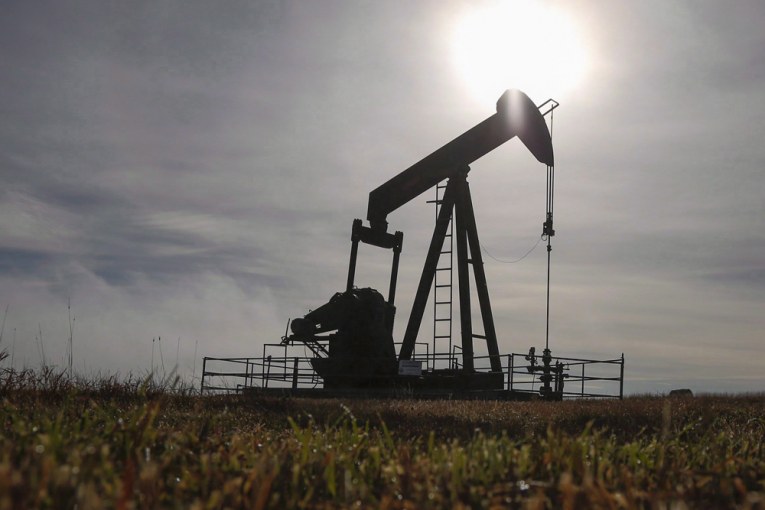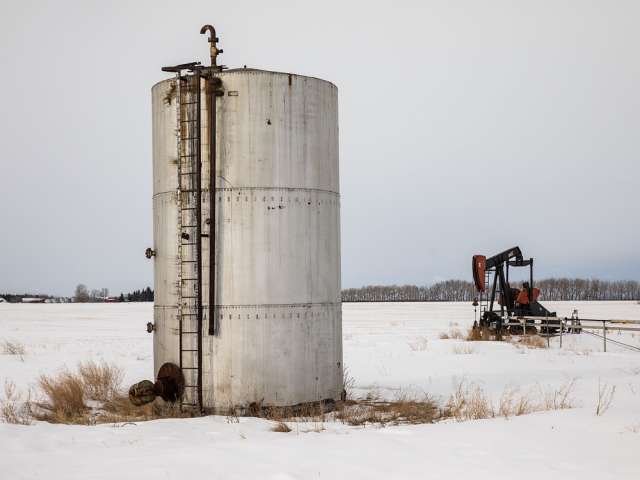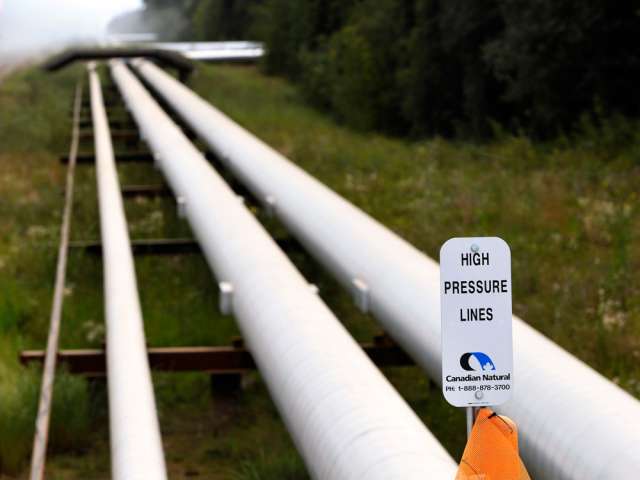
“Oil is dead.”
That’s how Green Party parliamentary leader Elizabeth May summed up the sector’s future on Wednesday while calling for more investment in renewable energy, rather than in pipelines or bailouts that could prop up the ailing oilpatch.
“My heart bleeds for people who think the sector is going to come back, because it’s not.”
May has long been one of the fossil fuel industry’s most ardent critics, but she isn’t the only one questioning whether Canada’s oil sector will ever fully recover from the current downturn, which, even for an industry used to boom-and-bust cycles, has taken on historic proportions.
Global oil demand has dropped by an estimated 30 per cent amidst social distancing policies designed to stop COVID-19, and that, combined with a price war between Russia and Saudi Arabia, helped push U.S. crude oil price futures into negative territory for the first time ever last month.
The price war has ended for now, but demand has not bounced back, forcing producers to scale back production as storage space rapidly disappears.
But despite these challenges, it’s far from clear that the current crisis will speed the decline of oil as an energy source and bring in a new era of renewables. On the contrary, some analysts say the current low prices could actually pave the way for global oil demand to grow in several years.
They point to the sheer size of the oil sector, estimated at around 100 million barrels of oil per day before COVID-19 took hold, and say it would take years, possibly even decades, before replacements can become cost-effective and readily available energy sources.
My heart bleeds for people who think the sector is going to come back, because it’s not
Elizabeth May
Nonetheless, oil certainly faces many of the same pressures that have beset coal, which is set to be phased out as a feedstock to generate electricity in Canada by 2030, including intense pressure from environmental activists as well as investors concerned about incorporating climate-change and carbon-emissions concerns into their portfolios.
These pressures have created questions about how the oil sector can grow, including whether another massive oilsands mine in Alberta will ever be built again. The pandemic has certainly changed demand, supply and market pricing in ways that are forcing many analysts to reconsider all their assumptions about the growth profile of oil.
“It’s not just that prices are low right now,” said Trevor Tombe, a professor of economics at the University of Calgary, “it’s that the uncertainty is so large.”
No one knows what will happen to demand after social-distancing policies are relaxed, let alone when this will happen, he said.
For example, will people return to pre-coronavirus levels of air travel for vacations or work conferences? Air Canada reported this week that it could take three years before its flights and earnings return to 2019 levels, after posting a $1-billion loss last quarter.
It’s not just that prices are low right now, it’s that the uncertainty is so large
Trevor Tombe
There are also questions about whether people will return to their offices to work or continue to work from home for either health or productivity reasons.
Either way, some oil companies are expecting a permanent downward shift on the demand curve for their products.
Earlier this week, Royal Dutch Shell PLC cut its dividend for the first time since the Second World War and its executives said they were bracing for permanent changes and long-lasting demand destruction — as May noted when she declared oil to be dead.
In spite of these headwinds, there are still many variables lining up in favour of an oil-sector recovery, perhaps even a resurgence, but the timeline is extremely uncertain and that, too, creates headwinds for investors.
Tombe pointed out that although U.S. crude oil price futures turned negative in April — meaning one party agreed to pay another party to take physical possession of oil — the price of futures a bit further down the line, in 2025, are around US$40 per barrel, a level that turns a profit for many producers, though not all.
“There’s still going to be hundreds of billions of dollars in global investment (in oil),” he said.
In Canada, with three new pipelines all advancing towards completion — the Trans Mountain Expansion Project, TC Energy Corp.’s Keystone XL and Enbridge Inc.’s Line 3 — oil producers will eventually be able to bring an additional 1.85 million barrels per day to market, according to the Canadian Association of Petroleum Producers.
That alone will attract investment to the industry, said Sam Goucher, a senior economist at the Conference Board of Canada.
“For Alberta, that’ll be huge,” he said. “It could really go a long way to preserving the longevity of the industry.”
Cheap gasoline prices (and fears of taking mass transit) may also entice people to drive their fuel-combustion cars further into the future, thereby slowing the growth of electric vehicles, which are still more expensive to drive.
“People talk about renewables all they want, that’s what you talk about when the world is in a happy place,” said David Neuhauser, managing director at Livermore Partners, and a director at Singapore-based Jadestone Energy Inc., which is looking to develop oil resources in South Asia. “When things get tight as they are now, people go back to the basics.”
Of course, the federal and provincial governments will play a role in any possible transition away from oil, especially in the short term as they craft industry-specific policies in response to the current economic crisis.
For example, the federal government has announced it will spend $1.7 billion to help clean up orphaned and abandoned wells in Alberta, British Columbia and Saskatchewan. That helps reduce a liability on oil company balance sheets, but may not be enough to entice further industry investment.

The program drew praise from the oil sector, since it likely helps people who provide services such as drilling‚ which has been most affected by the recent downturn. At the same time, provincial leaders in Alberta as well as oil executives said they would need tens of billions of dollars in additional federal aid to fund a full sector recovery.
The federal government hasn’t fully revealed all its policy responses, but it may well look to uphold its commitment to cut Canada’s emissions by 30 per cent by 2030. That could lead it to closely scrutinize any major expansions of oil production in Alberta or other parts of the country.
Chris Severson-Baker, a former energy regulator who is now Alberta regional director at the Pembina Institute, said the federal government appears to be committed to enacting policies consistent with meeting its carbon emissions reduction commitments.
For example, on April 1, it raised the carbon tax by 50 per cent to $30 per tonne from $20. The decision sticks to the planned $10 annual increase, but it faced increased pressure this year because of the coronavirus-related economic fallout, including more than three million jobs and an unemployment rate that hit 13 per cent nationally in April, and 13.4 per cent in Alberta, according to Statistics Canada.
Severson-Baker said economic downturns in the past may have displaced environmental concerns, but he believes times have changed.
“I think people in the world realize we’re running out of runway for dealing with climate change,” he said. “The human health and economic costs of climate change is starting to become much more real in people’s minds.”
Severson-Baker predicted the pandemic will remind people why it is important to have a coordinated government response to a global threat, whether it’s a virus or climate change.
He added that many oil companies want greater coordination between the provinces and the federal government on climate-related regulations. Recently, Alberta and other provinces have clashed with the federal government, filing litigation to challenge its authority to implement a carbon tax.
The lack of consistency in government regulation is one reason Vancouver-based Teck Resources Ltd. earlier this year withdrew its application for permits to build a $20-billion oilsands mine in Alberta, according to a long letter that chief executive Don Lindsay wrote in February to federal Environment Minister Jonathan Wilkinson.

Lindsay noted his company has committed to reducing its carbon emissions to net zero by 2050, and called for a unified climate policy.
“The promise of Canada’s potential will not be realized until governments can reach agreement around how climate policy considerations will be addressed in the context of future responsible energy sector development,” he said in the letter released February.
But Teck Resources has also been hurt badly by the recent downturn in prices and has already scaled back oil production. In April, the activist hedge fund Tribecca Investment Partners launched a campaign to pressure the company to entirely divest its oil-sector assets, saying it could see greater gains if it focused on base metals such as copper.
Many Canadian oil and gas companies have recognized the need to invest in “greener” technologies that will lower the carbon intensity of their operations, the ratings agency DBRS Morningstar noted on Thursday, calling it a response to industry divestment by key institutional investors, such as Norway’s US$1-trillion sovereign wealth fund.
The DBRS report, A Greener Shade of Oil: How Canadian Oil and Gas Issuers Address Climate Change Risk and the Potential for Clean Transition Bonds, noted some oil companies are already investing in carbon reduction.
For example, Canadian Natural Resources Limited Ltd. reduced its greenhouse gas emissions by 37 per cent between 2012 and 2018 through operational efficiencies, co-generation of power and new technologies.

Severson-Baker said he thinks many other oil and gas companies are starting to see Canada’s competitive advantage as tied to its ability to produce energy while mitigating carbon emissions, either through carbon capture, methane reduction or other emerging technologies being tested or used here already.
He said many oil companies even before the pandemic were figuring out how they would respond if oil demand declined though the next decade. Now that demand has dropped off because of social-distancing policies, it is an opportunity to test some of those planned strategies.
“A lot of the conversation I’m hearing is, ‘Did we just accelerate by 10 years, and now we’re in the reduced demand scenario?’” he said.
But many analysts say just as many oil companies view the current low levels of demand as a mere bump that will eventually pass, though there will be some short-term pain.
John Hunt, an analyst at National Bank Financial, said his team lowered their price targets and downgraded many oil companies’ investment ratings as the downturn set in.
Before the pandemic, many producers were scaling back from larger projects, he said, and that is likely to continue. But growth in Canada is still possible, but perhaps it will be more tied to phased expansions of existing projects rather than big-ticket greenfield development.
“There still is demand, and global demand growth,” Hunt predicted. “And there’s a view that oil prices will recover.”
Financial Post
• Email: [email protected] | Twitter: GabeFriedz
You can read more of the news on source
